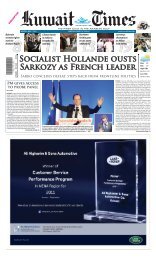otics may lead to future antibiotic-resistant infec - Kuwait Times
otics may lead to future antibiotic-resistant infec - Kuwait Times
otics may lead to future antibiotic-resistant infec - Kuwait Times
You also want an ePaper? Increase the reach of your titles
YUMPU automatically turns print PDFs into web optimized ePapers that Google loves.
FRIDAY, MARCH 16, 2012<br />
Arts<br />
is more powerful than money’<br />
collection Beautiful Inside My Head Forever<br />
(2008), which includes a zebra, a unicorn and<br />
a golden calf. There are pristine steel and<br />
glass cabinets full of neatly arranged pills, and<br />
evil-looking black paintings made of thousands<br />
of flies congealed in paint.<br />
There are spin paintings with and without<br />
human skulls at their centre, and spot paintings<br />
that move between the vibrant and the<br />
purely ambient. There are more flies, live<br />
ones, hatched from maggots and feeding off<br />
a severed cow’s head in a vitrine, and butterflies,<br />
pinned and painted and pressed on canvas,<br />
and a single white dove suspended in<br />
mid-flight above a human skull. Life and<br />
death, beauty and ugliness, the sacred and<br />
the profane; all the big Hirstian statements<br />
that have appalled some critics with their supposed<br />
obviousness, but have also dragged<br />
conceptualism from the margins of the art<br />
world in<strong>to</strong> the mainstream.<br />
Outside Tate Modern will stand Hymn<br />
(1999), Hirst’s monumental take on a child’s<br />
educational figure, complete with exposed<br />
s<strong>to</strong>mach organs. Inside, in the massive<br />
Turbine Hall, flanked by security guards, will<br />
sit a relatively tiny piece entitled For the Love<br />
of God (2007), the most expensive work of art<br />
ever created in terms of its materials: a human<br />
skull cast in platinum and encased in diamonds.<br />
A modern vanitas piece about death<br />
and money, but mostly about money.<br />
“Putting the show <strong>to</strong>gether,” says Hirst,<br />
“was like a big 180-degree turn for me. I’m<br />
looking back at all this work and trying <strong>to</strong><br />
make sense of it. Some of it is great, and some<br />
of it is unrealised and didn’t make it in there,<br />
and some of it is just shit. It’s 25 bloody years<br />
of work and, of course, I’m proud of it, proud<br />
that I put the effort in, but there’s also one<br />
part of me going, ‘How did that happen?’”<br />
How, indeed? It is a question that exercises<br />
the minds of his many detrac<strong>to</strong>rs in the art<br />
world: how did a mouthy, working-class lad<br />
from Leeds, with hooligan tendencies,<br />
become the biggest - and the richest - artist<br />
on the planet? (In the Sunday <strong>Times</strong> Rich List<br />
of 2010, Hirst’s wealth was estimated at<br />
£215m.) The answer is long and complex, and<br />
has much <strong>to</strong> do with the radical shifts in culture<br />
that have occurred over the past 25 years<br />
or so, both in Britain and the world: the<br />
uns<strong>to</strong>ppable rise of art as commodity and the<br />
successful artist as a brand; the ascendancy of<br />
a post-Thatcher generation of Young British<br />
Artists (YBAs) who set out, unapologetically,<br />
<strong>to</strong> make shock-art that also made money; the<br />
attendant rise of uber-dealers such as Jay<br />
Jopling in London and Larry Gagosian in New<br />
York; and the birth of a new kind of gallery<br />
culture, in which the blockbuster show rules<br />
and merchandising is a lucrative sideline.<br />
At the centre of this ultra-commodified art<br />
world stands Damien Hirst, art superstar: the<br />
richest, loudest, biggest YBA of all. Except<br />
that, no longer young, he seems - at the very<br />
moment when his canonisation by the art<br />
establishment is complete - <strong>to</strong> be in a long<br />
period of transition. When I last spoke <strong>to</strong> him,<br />
in September 2009, in his vast studio near<br />
Stroud, Gloucestershire, it was exactly a year<br />
after the as<strong>to</strong>unding success of Beautiful<br />
Inside My Head Forever, his record-breaking<br />
Sotheby’s auction of 2008. Back then, just<br />
before the world markets tumbled, Hirst<br />
made headlines by bypassing his dealers,<br />
Jopling and Gagosian, al<strong>to</strong>gether, and taking<br />
more than £111m in sales in two days of<br />
often-frenzied bidding. Right on the cusp of<br />
the recession, the Sotheby’s auction was a<br />
pivotal moment for Hirst - a grand farewell, he<br />
<strong>to</strong>ld me, <strong>to</strong> the “big work” he had been making<br />
for years. He also <strong>to</strong>ld me then that conceptualism<br />
was “a <strong>to</strong>tal dead end” and said:<br />
“You spend 20 years celebrating your immortality,<br />
and then you realise that’s not what it’s<br />
about.” Since then, he has been relatively quiet<br />
on the creative (if not the commercial)<br />
front, working mainly on his own paintings:<br />
that is, canvases on which he, and he alone,<br />
applies the paint. Many of them, including a<br />
series made after the suicide of his friend<br />
Angus Fairhurst in March 2008, were completed<br />
in a room in Claridge’s that his good friend<br />
Paddy McKillen (co-owner of the hotel)<br />
loaned him rent-free, in return for some paintings<br />
that now decorate the Connaught,<br />
another of McKillen’s London hotels.<br />
No Love Lost<br />
An exhibition of that work, No Love Lost,<br />
opened at the Wallace Collection in London in<br />
Oc<strong>to</strong>ber 2009 <strong>to</strong> uniformly murderous<br />
reviews, the late art critic Tom Lubbock comparing<br />
Hirst <strong>to</strong> “a not very promising first-year<br />
art student”.<br />
Undaunted, Hirst has continued <strong>to</strong> paint,<br />
and when I travelled down <strong>to</strong> his country<br />
home in deepest Devon a few weeks ago, he<br />
showed me briefly around his garden shed,<br />
where a paint-splattered stuffed bear s<strong>to</strong>od<br />
sentinel over a group of partially completed<br />
canvases, featuring brightly coloured parrots<br />
in lush landscapes and a single big painting of<br />
a human head in a wash of what you might<br />
call Bacon blue. A few stuffed parrots s<strong>to</strong>od<br />
on perches in the centre of the cluttered<br />
room, bright yellow and green, as if staring at<br />
their painted selves. “When all else fails,” Hirst<br />
quipped, “get yourself a few dead parrots.” It<br />
all seemed a long way from a giant blue shark<br />
in a tank of formaldehyde. “I’ve spent a long<br />
time avoiding painting and dealing with it<br />
from a distance,” he said. “But as I get older<br />
I’m more comfortable with it.”<br />
The house in Devon, where Hirst currently<br />
lives with his wife, Maia Norman, and their<br />
three children, is one of several properties he<br />
owns. He also has a stately home, Todding<strong>to</strong>n<br />
Manor, in Gloucestershire, that will one day<br />
house a collection of his own work. Near<br />
Stroud, he has another house with a vast studio<br />
attached, where, not that long ago, many<br />
of his 150-strong team of assistants laboured<br />
over his serial works: the spot paintings, spin<br />
paintings, cabinets and vitrines. He has a<br />
houseboat in Chelsea, a house in Thailand,<br />
where he spent Christmas, and another in<br />
Mexico, although he hasn’t been there for a<br />
while because “it’s a bit wild west out there at<br />
the moment”.<br />
In London, as well as Science, his organisational<br />
hub, he also owns a big chunk of<br />
Newport Street in Lambeth, which is currently<br />
being turned in<strong>to</strong> a new gallery that will open<br />
in 2014 and house his extensive collection of<br />
contemporary art by the likes of Bacon,<br />
Koons, Murakami, Richard Prince, Sarah Lucas<br />
and even Banksy - “We do these collaborations<br />
with my spots. I got one from him<br />
recently and he’d written all over it in big<br />
black letters: Sorry, The Lifestyle You Ordered<br />
Is Out of S<strong>to</strong>ck.”<br />
Over lunch in Hirst’s quayside restaurant in<br />
Ilfracombe, beneath a pristine glass cabinet<br />
full of pills, I ask him if it was always his motivation<br />
<strong>to</strong> be the biggest, the most successful?<br />
“I always wanted <strong>to</strong> be bigger, but not<br />
biggest. Even as a kid in drawing class, I had<br />
real ambition. I wanted <strong>to</strong> be the best in the<br />
class but there was always some other feller<br />
who was better; so I thought, ‘It can’t be<br />
about being the best, it has <strong>to</strong> be about the<br />
drawing itself, what you do with it.’ That’s<br />
kind of stuck with me. Being best is a false<br />
goal, you have <strong>to</strong> measure success on your<br />
own terms.”<br />
Art, ambition and money<br />
With Damien Hirst, though, it aways seems<br />
<strong>to</strong> come down <strong>to</strong> three things: art, ambition<br />
and money, though not necessarily in that<br />
order. For that reason, as cura<strong>to</strong>r Ann<br />
Gallagher asserts in her catalogue introduction<br />
<strong>to</strong> the Tate Modern show: “Like no other<br />
artist of his generation, Damien Hirst has permeated<br />
the cultural consciousness of our<br />
times.” What that says about us - and about<br />
Hirst - is a matter of some debate. Writing<br />
recently in the New Yorker on the simultaneous<br />
exhibition of all Hirst’s 1,500 signature<br />
spot paintings in all 11 Gagosian galleries dotted<br />
around the globe, the American art critic<br />
Peter Schjeldahl wrote: “Hirst will go down in<br />
his<strong>to</strong>ry as a particularly cold-blooded pet of<br />
millennial excess wealth. That’s not Old<br />
Master status, but it’s immortality of a sort.”<br />
Schjeldahl’s critical hauteur is not untypical.<br />
The bigger Hirst has become, the more he<br />
has become an object of scorn <strong>to</strong> some serious<br />
art critics, a symp<strong>to</strong>m of all that is wrong<br />
with contemporary art - and the rampant,<br />
market-led capitalism that drives it - as well as<br />
an easy target for the flak directed at conceptual<br />
art in general. “His work,” writes<br />
Gallagher, measuredly, “is characterised by its<br />
directness as well as its ambition; it is both<br />
deadpan and affecting, and it provokes awe<br />
and outrage in equal measure.”<br />
That, one senses, is exactly how Hirst - mellower<br />
these days, but still a northern prole<br />
with attitude <strong>to</strong> burn - likes it. Is there a little<br />
part of him that still rejoices in the notion that<br />
he is, at heart, a working-class lad who is<br />
somehow sticking it <strong>to</strong> the <strong>to</strong>ffs of the art<br />
world? “All of me, I’d say,” he replies, cackling.<br />
“I mean, I don’t fit, do I? I can play the game,<br />
but I don’t really fit. But you get older and you<br />
realise that rebellion doesn’t really matter <strong>to</strong><br />
the market. I kind of learned that early on and<br />
I’ve never forgotten it.” How early on? “Well, I<br />
remember in about 1989, when I was still an<br />
outsider and all my mates were having shows<br />
and I wasn’t, and it really bugged me. As I was<br />
making the fly piece, I was thinking: ‘I’m<br />
gonna show you. I’m gonna kill you with this<br />
one, knock you down dead, and change the<br />
world.’ And I showed it <strong>to</strong> a few galleries and<br />
they all just turned round and went<br />
‘Marvellous, darling.’ It didn’t have the effect I<br />
wanted. It had the opposite effect. I was gutted,<br />
in a way.” As a young teenager, Damien Hirst<br />
wanted most of all <strong>to</strong> be a punk, but, as he now<br />
puts it, “I was just <strong>to</strong>o young and not angry<br />
enough.” He remembers his mother melting his<br />
one Sex Pis<strong>to</strong>ls record <strong>to</strong> fashion it in<strong>to</strong> a plant<br />
holder, and he remembers sneaking out, aged<br />
12 or 13, with his “punk clothes” hidden in a<br />
bag, then changing in<strong>to</strong> them when he was out<br />
of sight of his house. “I think that attitude crept<br />
in<strong>to</strong> my art somehow. I was always looking for<br />
ways <strong>to</strong> sneak stuff in<strong>to</strong> the art world and make<br />
it explode in their faces. I was an infiltra<strong>to</strong>r.”<br />
Growing up in Leeds, Hirst was a handful for his<br />
mother, Mary Brennan, who worked in the local<br />
Citizens’ Advice Bureau. His punk phase came<br />
just after the man he thought was his father<br />
walked out on the family when Hirst was 12. He<br />
also went through a brief shoplifting phase - he<br />
was arrested twice - before he was finally<br />
accepted on his second application <strong>to</strong> study<br />
an art foundation course at Jacob Kramer<br />
College in Leeds.<br />
As a teenager, he made regular visits <strong>to</strong><br />
Leeds University’s Ana<strong>to</strong>my Museum <strong>to</strong> practise<br />
drawing, and it was there he found inspiration<br />
for his first piece of shock art: a pho<strong>to</strong>graph<br />
mounted on a steel frame called With<br />
Dead Head, first exhibited in 1991, in which<br />
his 16-year-old self poses, grinning, beside<br />
the severed head of a middle-aged man<br />
which sits on a mortuary table. It set the<br />
scene, if not the <strong>to</strong>ne, for much of what was<br />
<strong>to</strong> follow.<br />
Hirst moved <strong>to</strong> London in the mid-1980s,<br />
and for a time worked on building sites,<br />
before being accepted <strong>to</strong> Goldsmiths in 1986.<br />
There, under the tutelage of the artist Michael<br />
Craig-Martin, he realised that for the time<br />
being, at least, painting was over and that, in<br />
contemporary art, the idea was the be all and<br />
end all.—Guardian

















